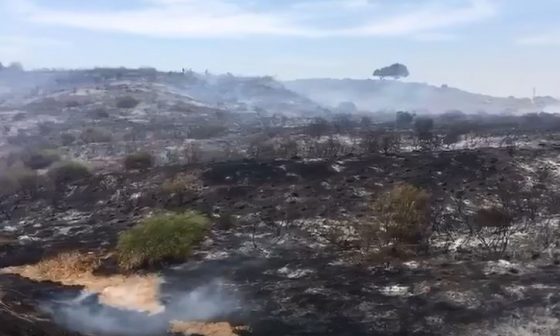BESA Center Perspectives Paper No. 871, June 20, 2018
EXECUTIVE SUMMARY: Hamas’s kite terrorism may not pose an existential threat, but by turning thousands of hectares of farmland into a wilderness and undermining Israel’s ability to provide peace and security for its frontier residents, it poses a threat that must be removed without delay.
Hamas’s setting of wildfires on thousands of hectares of natural woodland and farmland on the Israeli side of the Gaza border is a calculated and organized strategy. The immense damage being caused to property, wildlife, and natural resources is gradually transforming the area around the Strip into a wilderness, undermining Israel’s ability to provide peace and security to its residents.
The kibbutz movement did well to demand an end to this new terrorist modus operandi. And while the rules of engagement are undoubtedly the exclusive prerogative of the Chief-of-Staff rather than a subject for public debate, by demanding action the kibbutz movement has proved yet again that in the enforcement of state sovereignty, especially in frontier areas, there is no substitute for civilian steadfastness and clinging to the land.
This stands in stark contrast to the withdrawal from al-Hama in April 1951 after an IDF force that had been sent to patrol an area that was under Israeli sovereignty ran into a Syrian ambush that killed seven soldiers. Had there been a civilian community there, the withdrawal might well have generated an outcry and a demand for a more determined military response. In this respect, the kibbutz movement’s demand for a decisive response is emblematic of the traditional pioneering role of frontier communities.
Hamas’s management of the struggle along the fence displays an impressive degree of systemic adaptation. Anxious to avoid an all-out war, and keenly aware of the necessity of finding new means of sustaining the struggle, Hamas has been quick to realize the immense potential of kite terrorism. On the physical level, this method exhausts Israeli security and emergency forces on a daily basis. On the cognitive and legal levels, the activities – which are in some cases carried out by young boys – place Israel in a difficult political and diplomatic position in the international arena.
Although kite terrorism is presented as posing no direct threat to human life, its scope and significance cannot be denied. The question is this: is the state entitled to protect its assets and sovereignty only in those cases where there is a clear danger to human life?
The Talmudic literature recognized the uniqueness of the frontier long ago and established special rules that facilitated its distinct struggle for existence. The Sabbath regulations, for example, include a special stipulation allowing frontier residents to fight on the holy day in defense of their property. In the words of the Holy Scriptures: “Robbers who attack frontier Jews on the Sabbath should be fought even if they only tried to rob straw and hay.”
In other words, even a minor matter that does not ordinarily involve a life-saving situation becomes sufficiently life-threatening whenever it applies to frontier areas and, as such, justifies violating the Sabbath. This encapsulates the underlying ethos of frontier existence: those who cannot protect their straw and hay will have a hard time protecting their lives.
Moshe Dayan, as the Chief-of-Staff who masterminded the retaliation strategy of the early 1950s, explained the rationale of the IDF’s action: “The Arab states will not fight the infiltrators or punish them unless they find this to be in their own interest. The Arab army will awake to the need to fight infiltration only when it realizes that stealing a cow in Ramat Hakovesh is liable to hurt Qalqiliya and that murdering a Jew in Ruhama endangers the residents of Gaza.”
The stealing of a cow and the burning of a field are not in and of themselves an existential threat. But by accumulating into a critical mass, they pose a threat that no sovereign state can afford to leave unanswered.
An earlier version of this article was published in Israel Hayom.
Maj. Gen. (res.) Gershon Hacohen is a senior research fellow at the Begin-Sadat Center for Strategic Studies. He served in the IDF for forty-two years. He commanded troops in battles with Egypt and Syria. He was formerly a corps commander and commander of the IDF Military Colleges.
BESA Center Perspectives Papers are published through the generosity of the Greg Rosshandler Family


